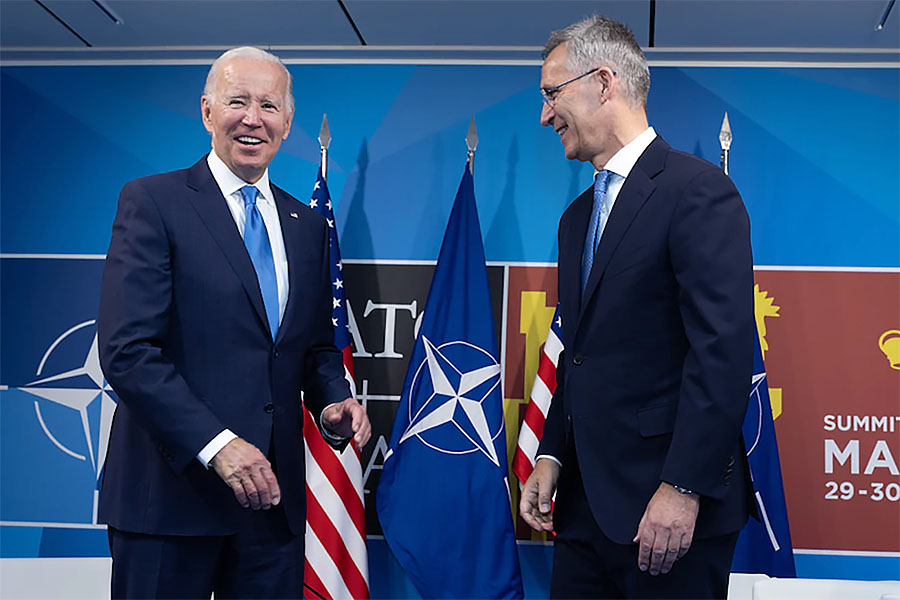WARZONE. President Joe Biden announced moves that will enlarge the U.S. troop presence in Europe and strengthen the NATO alliance. Biden made the announcement at the beginning of the NATO Summit in Madrid today following a welcome from NATO Secretary-General Jens Stoltenberg.
By Jim Garamone, U.S. Department of Defense, Pentagon, Washington
The move belies efforts by Russian President Vladimir Putin to shatter the Trans-Atlantic alliance. ”NATO is strong, united, and the steps we’re taking during this summit are going to further augment our collective strength,” Biden said. ”To that end, today, I’m announcing the United States will enhance our force posture in Europe to respond to the change security environment, as well as strengthening our collective security.”
The president’s announcement comes on the heels of a surge of 20,000 U.S. service members to Europe to defend alliance countries in the face of Putin’s unprovoked and unnecessary war on Ukraine. There are now more than 100,000 U.S. service members serving in Europe with many along the eastern front of the alliance.
The changes the president announced have been made in close consultation with allies and will be made over the coming months.
John Kirby, strategic communications coordinator at the National Security Council, said the move comes after President Biden has worked for several months to shore up NATO’s eastern flank.
”Just since the invasion itself, he ordered the deployment or extension of over 20,000 additional forces to Europe, in response to the crisis, across all domains — air, land, maritime, cyberspace — the whole swath of U.S. military capabilities,” Kirby said.
The Madrid Summit must deal with a fundamentally changed security environment, and Biden’s announcement is part and parcel of that. The president’s moves ”are reflective of the United States government’s recognition that the security environment has changed and, in particular, in the NATO that the Eastern countries are facing a heightened threat from a Russian leadership that has shown itself willing and capable of launching military attacks on bordering countries,” said Celeste A. Wallander, the Defense Department’s assistant secretary for international security affairs.
At the summit, Biden said he will increase from four to six the number of U.S. destroyers based at Rota Naval Base, Spain. ”In Poland, we’re going to establish a permanent headquarters of the U.S. 5th Army Corps and strengthen NATO interoperability across the entire eastern flank,” he said.
The Army’s V Corps headquarters will be a forward command post, an Army garrison headquarters, and a field support battalion, said DOD officials traveling with Secretary of Defense Lloyd J. Austin III, who is also attending the summit. The forces will improve command and control capabilities, interoperability with NATO, and management of prepositioned equipment.
Poland has been a steadfast ally and enabler of many of the alliance’s moves, officials said. The United States will also maintain the substantial rotational force presence in Poland, including an armored brigade combat team, a combat aviation brigade element, and a division headquarters element. This enables DOD to deploy combat forces up and down the eastern flank, officials said.
In Romania, the United States will position a rotational brigade combat team. This additional brigade will also maintain the ability to deploy subordinate elements. The U.S. will also enhance its rotational deployments in the Baltic republics. These include armored, aviation, air defense and special operations forces.
The U.S. military will also maintain a persistent, heel-to-toe presence in the region and will intensify training with Baltic allies to maintain combat-credible capabilities, officials said.
Biden also announced deployment of two additional F-35 squadrons to RAF Lakenheath in the United Kingdom. These fifth-generation fighters will add to the air support for NATO forces throughout Europe.
The president said he will also deploy additional air defense, logistics and engineer assets in Germany and add air defense capabilities to forces in Italy.
These changes come on the heels of deployments made since Putin invaded Ukraine and directly challenged the rules-based infrastructure that has served the world since World War II. The U.S. response included sending airborne forces from Italy to the eastern flank, Stryker units to the front-line states, Patriot batteries to Slovakia and Poland, and F-15s from the United Kingdom to Poland.
In addition, Austin placed thousands of U.S. troops designated for NATO’s Rapid Reaction Force on heightened alert for possible deployment to Europe.
By Jim Garamone, U.S. Department of Defense, Pentagon, Washington


